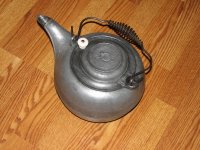-
If a web search for the answer to your cast iron cookware question has brought you directly to this forum, the information you seek may be covered in one of the many reference topics featured on the main website.
Quick Links: · Main Website · How to Identify Unmarked Pans · All About Cleaning & Seasoning · Reproductions & Counterfeits · Commonly-Used Terms
You are using an out of date browser. It may not display this or other websites correctly.
You should upgrade or use an alternative browser.
You should upgrade or use an alternative browser.
Electro cleaning a galvanized tea kettle
- Thread starter James M
- Start date
W. Hilditch
Active member
I suspect if it was aluminum it wouldn’t have any rust. A galvanized coating would be unique. If it is well attached chrome or nickel it should be fine but I don’t know about galvanized pieces. My “Now What?” pot posted under General Cast Iron had an unknown coating that was not effected by e-tank cleaning or lye. I'd give it a try & watch.
Hilditch
Hilditch
Romunda Murphy
Member
Isn't "galvanized" material poison if heated ,just asking ,and at what point
AaronWells
New member
Isn't "galvanized" material poison if heated ,just asking ,and at what point
Working as a safety coordinator in the construction industry I can tell you that galvanized metals do give off toxic fumes when welding or arc gouging.
It's my understanding that these fumes are not a gas or vapor, but rather a very fine particulate that is created when the metal is destroyed at high heat. While it is hazardous to inhale, a basic dust mask (in theory) would be enough to fully protect the worker.
As long as you aren't destroying it with heat, no toxin is released. Cooking/electrolysis should be fine.
AaronWells
New member
The material is zinc. I myself would avoid using for cooking, frying,etc.
Full respiration gear is strongly suggested. A dust mask might handle grinding but not heating the material. Frankly high speed grinding would heat the material and produce vapor.
That's why I said "(in theory)". The failing in the dust mask is in the seal, not the mask itself. Even a 2097 filter designed for hex chrome and zinc, which we require at our site, is still only a particulate filter. The hazardous fume produced is a tiny solid, not a gas.
Bonnie Scott
Active member
Wow...that is super cool. :icon_thumbsup:
Sharon Shuman
Member
Elegant tea kettle! Thanks for sharing.

